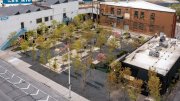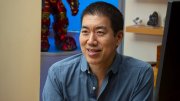Sociology professor Bruce Western often asks his students, “How would you like to be defined by the worst thing you’ve ever done?” By and large, that is still the way society views current and former prison inmates. Meanwhile, few of the people who make the laws and policies that determine who goes to prison have had much personal interaction with those whom their decisions affect.
Seeking to bridge this gap, Western and others are bringing Harvard students and scholars face to face with inmates and into the disadvantaged neighborhoods that feed their residents into prisons by the dozen.
Fieldwork with the Urban Poor
For example, “The American Ghetto,” a junior tutorial taught by assistant professor of sociology and social studies Matthew Desmond, requires fieldwork in an impoverished Boston neighborhood, with the goal of “putting future teachers, future lawyers, future policymakers shoulder to shoulder with the urban poor, so when they encounter stereotypes of poverty, they can remember their experience and challenge that.” The course examines joblessness, the drug economy, single motherhood, and youth violence—all phenomena closely tied to the prison boom. In addition to readings and discussion sections, students spend time at a field site each week, examining a research question. They are encouraged to challenge the established frameworks sociologists use to understand poverty.
Caroline Burke ’13, who is also a research assistant in Western’s investigation of former inmates’ experiences reintegrating into society (see main article), spent time with people applying for welfare. Her ethnographic account of the experience, “Death by a Thousand Papercuts,” chronicles the difficulty people encountered in getting information about whether they qualified and how to apply. Frequently, applicants were sent to the back of the line or told to come back another day for having a slight error in a filled-out form.
Nicolas Jofre ’13 spent Friday nights last semester outside a bodega at a public housing project in Boston’s Mission Hill neighborhood; the area near the bodega was a hotspot for public drunkenness, drug-dealing, and other illicit activity. Among the people he interviewed and shadowed during their daily activities was a man who, in his early twenties, had shot someone and served 14 years behind bars. Recently released, he had returned home to find that the housing project had been substantially renovated—drastically reducing the number of subsidized housing units available. Those with criminal convictions were the first to be excluded. Unable to qualify for a rental unit or find a job, he stayed on friends’ couches and turned to selling drugs during the day, becoming part of a group of former residents, now homeless, who loitered outside the bodega.
Although most project residents wanted a safe neighborhood, they also knew many individuals in this group and, despite their behavior, felt sympathy for them. To distinguish between law-abiding residents and criminal outsiders, Jofre found, would be oversimplifying: “The ties across these two groups remained quite strong. Members of both groups knew each other by name and had friends in common. Some were even related.” Project residents therefore tolerated the illicit behavior—but, as Jofre discovered, an unspoken rule decreed that such behavior stay near the bodega, and not migrate to the playground or grounds of the elementary school nearby.
Criminal-justice discourse in the United States is driven by notions of right and wrong, punishment and retribution—but this discourse “breaks down completely when you get into the realities of people’s lives,” says Western. It’s hard to justify harsh punishment and long sentences when one sees the daily struggles and stark disadvantages of the urban poor.
Western’s prison-based sociology course, in which Harvard students study alongside inmates, defied expectations—his own and his students’—from the time it began in 2008. Though educational attainment is generally low within the prison population, the inmates who took the course were pursuing bachelor’s degrees through Boston University. They had to be intelligent and goal-directed to qualify for the selective program—and they had plenty of time to read. That raised course discussion to a high intellectual level, Western reports, in part because the Harvard students, inspired by just how much the inmates didn’t take this educational opportunity for granted, also did all the reading.
Unlike many experiences that bring Harvard students into contact with those less fortunate, the premise of Western’s course is that all the students in the class stand to learn from one another. (Western credits Kaia Stern, a lecturer on ethics at Harvard Divinity School, with challenging him to view the classroom dynamic this way; Stern has collaborated with Western in teaching the course and establishing it as a regular fixture in the Harvard course catalog.) When the first session ended, the undergraduates wrote a letter urging the sociology department to offer it again. “We were not there to tutor or mentor” the inmates, they wrote, “but to participate alongside them.”
Western’s course, like Desmond’s, has produced student research that adds meaningfully to sociological knowledge. Marissa Reichel ’12 has found that prison-based general education diploma (GED) programs, which enable inmates to earn the equivalent of a high-school diploma by taking classes and a test while incarcerated, do have some benefit. Previous research had shown that inmates who earn a GED gain no lasting advantage, relative to peers who don’t earn the credential, in terms of getting a job and staying out of prison once released. That led many to question GED programs’ value.
Reichel decided to examine data from a national adult-literacy test, and found that the GED confers a significant benefit: earning the diploma served to close more than two-thirds of the literacy gap between the average inmate and the average American. For this reason alone, she concluded, the GED is not a waste of time. “Simply being able to read to one’s child, read and understand newspaper events, and figure out the tip at a restaurant may improve well-being and one’s fuller participation in society,” she wrote. But she also asked why this improved literacy does not lead to improved employment prospects. Education alone, it seems, is not enough to equip the formerly incarcerated for success in the job market.
Catherine Sirois ’10, now project manager for Western’s reintegration study, was moved by inmates’ stories of missing their children’s soccer games and high-school graduations to write her senior thesis on the effect on families of a father’s incarceration. She came to believe that it’s impossible to punish fathers without harming their children, and became passionate about finding ways large and small to break the cycle of incarceration in families and poor communities.
In her thesis interviews, Sirois heard fathers’ anguish about the conditions in which their children’s prison visits took place. With glass partitions often preventing even a simple hug, many fathers decided the experience was so traumatic for the children, it was better for them not to come. She lauds prisons that have family-friendly visiting rooms with toys and games, where hugs are allowed, and recommends making this the standard arrangement.
Now, when Sirois answers friends’ questions about her work with prisoners—inevitably, “What did he do?” comes up—she refuses to give the expected reply, answering instead, for example, “He raised two kids”—and hoping to break down, bit by bit, the habit of defining a person based on a criminal record.
Western is gratified that his students are considering how social institutions such as public schools and prisons themselves might contribute to or detract from mass incarceration. “As sociologists, we need to be doing this more,” he says. “We need to be getting out and confronting the reality of how people are living.”
Advocacy on the Inside
“Hello, Harvard PLAP. Can I please have your name and con number?”
Multiple times each hour on weekdays, this introduction is repeated in the office of the Prison Legal Assistance Project at Harvard Law School. For 40 years, law students have taken shifts answering calls to the hotline, advising Massachusetts prisoners of their rights vis-à-vis the administrative code of prison rules, and representing prisoners at disciplinary hearings. Before providing counseling, the students verify that the caller is an inmate in the state prison system. Although they limit their services to this population, they are able to honor only one-fifth of the requests for representation at a hearing.
An inmate might be accused of assault or faking an illness, brewing alcohol or possessing contraband bubblegum. The consequences can be significant: not just the possible loss of phone or canteen privileges, but transfer to a higher-security facility or decreased chance of being released on parole.
When second-year student Gerard Cedrone tells people about his work with PLAP, a common reaction is, “Why don’t people in prison just follow the rules?” He explains that there are so many rules—and they are so broad, and sometimes contradictory—that it is almost impossible to follow all of them. “I don’t think anyone—including myself—could live in that facility for one month without breaking a rule,” he says.
Some rules are broken routinely, but are nevertheless invoked by correctional officers who dislike certain inmates or want to ratchet up the penalty levied for a different infraction. For example, the rules prohibit blocking one’s cell window, but inmates customarily do so while using the toilet. “Everyone does it,” says first-year student Donna Harati, yet one of her clients is being disciplined under this rule. The real reason, she says: “People dislike him for the offense he committed.”
Like the undergraduates in Western’s prison-based sociology course, the law students find inmates more sympathetic than they expected. The reality of a person “never matches up to something you read on a piece of paper about what they’ve done,” says third-year student Mara Sacks. Some PLAP participants have decided they want to work with prisoners and criminal suspects, either through their jobs or through volunteer work. Others aspire to criminal prosecution but say this work has broadened their perspective.
The students’ advocacy often fails. The standard of proof in these hearings is “a preponderance of the evidence”—short of the presumption of innocence in criminal proceedings—and hearing officers tend to find correctional staff more believable than inmates. But the law students believe their work has an impact regardless of the outcome. After a hearing in which second-year student Jeanne Segil failed to obtain a ruling in her client’s favor, the client’s sister approached Segil and told her, “You saw something in my brother that no one else has.”
Segil says winning is only part of the point. “I believe in the power of just sitting by someone’s side when he’s handcuffed and the parole board is interrogating him,” she says. “I believe there’s power in just being present.”








